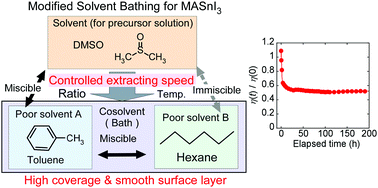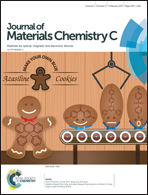Fabrication of high coverage MASnI3 perovskite films for stable, planar heterojunction solar cells†
Abstract
The development of lead-free organic–inorganic perovskite absorbers for solar cells is an important step toward commercializing this technology. Tin halide perovskites are a proposed alternative to lead perovskites; however, their performances show high levels of instability owing to the low quality of these perovskite films. In this work, we used a modified solvent bathing method to fabricate tin halide perovskite films. To control the formation speed of the perovskite films, we combined anti-solvents with miscibilities different to those of the precursor solvent in an appropriate ratio and at an appropriate temperature. Thus, we were able to significantly improve the coverage of the perovskite films. A planar perovskite solar cell with a film prepared using this method showed an efficiency of 2.14 ± 0.35% with an open circuit voltage of 0.45 ± 0.01 V, which is higher than that of solar cells with a conventionally prepared active layer. Additionally, we achieved a significant reproducibility in performance in comparison with previously reported devices. Further, the solar cells had unexpectedly long lifetimes of over 200 h under 1 Sun degradation conditions (AM1.5, 100 mW cm−2); generally, tin perovskites degrade quickly. We propose that the comparably high open circuit voltage and stable photovoltaic properties of our tin halide perovskite solar cells is the result of the high surface coverage of the perovskite film, which was achieved using the modified solvent bathing method.



 Please wait while we load your content...
Please wait while we load your content...